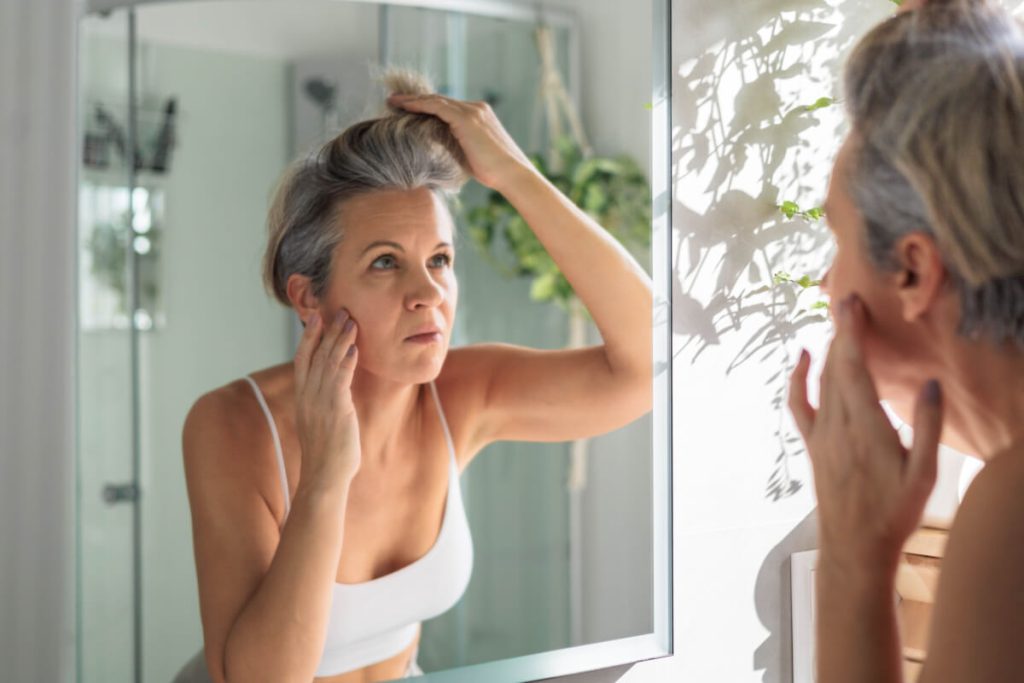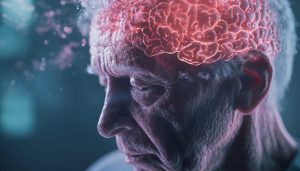

(© kostikovanata – stock.adobe.com)
Anti-aging comes down to chemicals made in your body, instead of those found on store shelves
In a nutshell
- Hormones like IGF-1, estrogens, and melatonin play crucial roles in controlling skin aging processes through their effects on collagen production, oxidative stress, and DNA repair.
- The skin is not just a target for hormones but an active hormone-producing organ itself, creating many of the compounds that influence its own aging.
- Future anti-aging treatments may leverage hormones like melatonin, oxytocin, and modified α-MSH to create more effective therapies than current approaches using retinoids and estrogens.
MÜNSTER, Germany — In the battle against wrinkles, sagging, and age spots, many people focus on expensive creams, serums, and treatments. But what if the most powerful anti-aging factors are already inside your body? Research published in the journal Endocrine Reviews reveals how hormones—chemical messengers that regulate nearly every bodily function—play a crucial role in how our skin ages.
“Our paper highlights key hormone players that orchestrate pathways of skin aging such as degradation of connective tissue (leading to wrinkling), stem cell survival and loss of pigment (leading to hair graying),” said lead author Dr. Markus Böhm, of the University of Münster, in a statement. “Some of the hormones we studied have anti-aging properties and may be used in the future as agents to prevent skin aging.”
The review, authored by researchers from several European and American institutions, provides a deep dive into the relationship between our endocrine system and skin aging. It positions the skin as not just a target for hormones produced elsewhere in the body, but as a hormone-producing organ itself.
“Skin is not only a target for various hormones that control pathways of skin aging but itself is certainly the largest and richest site for hormone production besides classical endocrine glands,” Böhm said.
As we age, our skin undergoes two distinct processes: intrinsic aging, which happens naturally over time due to genetic factors, and extrinsic aging, caused by environmental factors like UV radiation and pollution (collectively known as the “exposome”). While these processes have different manifestations, they share common mechanisms—increased reactive oxygen species (which are harmful molecules that damage cells), breakdown of the skin’s supporting structure, shortening of protective caps on our DNA, and accumulated DNA damage.


Which hormones play the biggest role in skin aging?
Numerous hormones, from insulin-like growth factor 1 (IGF-1) to estrogens, melatonin, and vitamin A derivatives (retinoids), all influence cellular processes that determine how our skin ages.
For instance, IGF-1, produced by dermal fibroblasts (cells that make connective tissue), emerges as a key player in skin aging. When fibroblasts become senescent—essentially entering a zombie-like state where they can’t divide but don’t die—they produce less IGF-1. This reduction leads to skin thinning, wrinkles, and reduced barrier function. In essence, senescent fibroblasts accelerate skin aging by failing to provide this crucial hormone.
Similarly, estrogens play a vital role, particularly in postmenopausal women. The dramatic drop in circulating estrogen that occurs during menopause contributes to a 30% decrease in skin collagen during the early postmenopausal years, with continued loss at approximately 2% per year thereafter. This explains why many women notice accelerated skin aging during and after menopause.
Another fascinating aspect is how the hair follicle—often overlooked in aging discussions—functions as a “mini-organ” with its own hormonal production system. Hair graying, often the first visible sign of aging, occurs when the hair follicle’s pigment-producing unit loses functional stem cells. Pattern hair loss in men and women also involves hormone-driven changes that shrink hair follicles over time.


Melatonin is especially interesting as a potential anti-skin aging substance as it is a small molecule, inexpensive, well-tolerated, and a powerful antioxidant as well as a regulator of cellular energy production. Best known as the “sleep hormone,” melatonin appears to be a powerful protector against UV damage and oxidative stress in the skin. It works both as a direct free radical scavenger and by boosting the body’s natural antioxidant enzymes.
The skin’s ability to produce hormones locally makes it a complex endocrine organ in its own right. For example, the skin produces its own version of the “stress hormone” cortisol and can convert vitamin D precursors into active forms. This local production means that skin can respond to stressors even without input from the brain or other endocrine glands.
Other potential endocrine ‘influencers’
Researchers also reviewed the emerging roles of additional endocrine players, including α-melanocyte-stimulating hormone (responsible for skin pigmentation), members of the thyroid hormone system, oxytocin, endocannabinoids (found in CBD products), and peroxisome proliferator-activated receptor modulators and found they have very promising effects on UV-induced DNA damage crucially involved in the development of photoaging and pigment synthesis within skin and hair.
Oxytocin — commonly associated with childbirth, breastfeeding, and social bonding — may prevent skin aging by reducing inflammation and oxidative stress. The researchers identified oxytocin as one of several emerging endocrine players with promising anti-aging properties, particularly through its effects on inflammatory pathways that contribute to skin aging.
Even cannabinoids—compounds similar to those found in cannabis but produced naturally in the body—play a role in skin aging through their effects on inflammation, cell growth, and wound healing. The skin’s endocannabinoid system works to maintain an anti-inflammatory environment that may protect against some aspects of aging.
The future of anti-aging skin therapies
Currently, topical retinoids and estrogens are the most commonly used hormonal anti-aging compounds in clinical practice. Until now, only these limited number of hormones, mainly topical retinoids (retinol and tretinoin) and estrogen, which is typically used to treat side effects of menopause, have been used in clinical practice as anti-skin-aging compounds.
Retinoids like retinol and tretinoin have been shown to reduce abnormal skin cells, increase collagen thickness, and stimulate production of new collagen in sun-damaged skin. For postmenopausal women, hormone replacement therapy has been shown to increase skin thickness, improve hydration, and reduce wrinkles.


However, the review points toward potential new therapies that target other hormonal pathways. Melatonin, with its impressive antioxidant properties, could become a powerful addition to anti-aging skincare. Modified forms of α-MSH are being developed for better skin penetration and could offer protection against UV damage while preserving their antioxidative effects.
The aging of our largest organ affects more than just appearance. Aged skin has reduced barrier function, decreased wound healing capacity, and increased susceptibility to infections and skin cancers. Understanding the hormonal controls of skin aging could lead to interventions that address these health concerns alongside cosmetic ones.
“Further research into these hormones may offer opportunities to develop new therapeutics for treating and preventing skin aging,” Böhm said.
Future anti-aging strategies might involve “smart endocrine cocktails”—combinations of hormones or hormone-like compounds that work together to target multiple aspects of skin aging. For example, combinations of modified α-MSH with thyroid-releasing hormone and/or estradiol might simultaneously reduce oxidative stress, increase melanin production, and improve collagen synthesis.


For those concerned about skin aging, the key message is that internal hormonal balance matters as much as—if not more than—external skincare products. The body’s endocrine system plays a crucial role in maintaining skin health and youthfulness, and disruptions to this system accelerate visible aging.
Above all, before you start taking any supplements or try any anti-aging therapies, you should absolutely check with your doctor first. Not only can these remedies be expensive, but they can also come with side effects in which some people are at higher risk than others.
Paper Summary
Methodology
This paper is a comprehensive review that brings together findings from numerous studies rather than presenting new experimental data. The authors examined existing research on how hormones influence skin aging. They gathered and analyzed published studies on both chronological aging and environmentally-caused aging, with a focus on how various hormones affect the underlying mechanisms. The review provides an organized analysis of the current scientific understanding of how different hormonal systems influence the cellular and molecular processes of skin aging. Rather than collecting new data, the authors identified patterns and connections across existing research to develop a comprehensive framework for understanding the endocrine controls of skin aging
Results
The review identified several key hormones that play crucial roles in skin aging. IGF-1 emerged as a central coordinator of cellular senescence in skin, with decreased levels leading to depletion of stem cell pools and impaired skin regeneration. Growth hormone influences IGF-1 levels but has complex effects; while it increases skin thickness, it may also promote premature aging in certain contexts. Estrogens maintain skin collagen content, with postmenopausal estrogen deficiency leading to approximately 30% collagen loss in early menopause. Retinoids showed significant effects on reducing sun damage by enhancing collagen production and reducing enzymes that break down the skin’s supporting structure. Melatonin demonstrated powerful protective effects against UV-induced damage through multiple mechanisms, including direct radical scavenging and enhancement of DNA repair. The review also highlighted emerging evidence for anti-aging effects of α-melanocyte-stimulating hormone (through enhanced DNA repair and antioxidant functions), oxytocin (through enhanced protective molecules and reduced inflammation), and endocannabinoids (through regulation of inflammatory responses). The results collectively demonstrate that skin aging is under tight hormonal control from both classical endocrine systems and the skin’s own hormone production.
Limitations
The authors acknowledge several limitations to their review. First, while they focused on human skin aging, much of the detailed understanding comes from animal models and laboratory studies, which may not perfectly translate to human skin in real life. Second, the complex interactions between different hormonal systems make it difficult to isolate the effects of individual hormones. Third, there’s limited clinical evidence for many of the emerging hormonal influences discussed, particularly for newer targets like oxytocin and endocannabinoids. Fourth, age-related changes in hormone production and responsiveness vary significantly between individuals due to genetic factors, lifestyle, and environmental exposures, making general conclusions challenging. Finally, the authors point out that only a limited number of hormonal anti-aging compounds (primarily topical retinoids and estrogens) have made their way into clinical practice, highlighting the gap between theoretical understanding and practical applications in treating skin aging.
Discussion and Takeaways
The review emphasizes several important points for future research and clinical applications. First, it positions the skin as not just a target for hormones but as an active endocrine organ capable of producing and metabolizing hormones locally. This means that blood hormone levels may not fully reflect hormonal activity in the skin. Second, the authors suggest that future anti-aging strategies might involve combinations of hormonal compounds that work together to target different aspects of skin aging. Third, they highlight the potential of relatively unexplored hormones like melatonin, which has impressive protective and antioxidant properties that could make it an ideal anti-aging compound. Fourth, the discussion points to the importance of the hair follicle as a hormone-producing “mini-organ” that undergoes its own aging processes. Finally, the authors suggest that as our understanding of hormonal influences on skin aging deepens, we may develop more personalized approaches to anti-aging treatments that account for individual hormonal profiles and aging patterns. The overarching takeaway is that hormonal modulation represents a promising but still largely untapped approach to addressing both the cosmetic and health-related aspects of skin aging.
Funding and Disclosures
The researchers received funding from the Deutsche Forschungsgemeinschaft, the University of Miami Leonard M. Miller School of Medicine, the International Graduate School in Molecular Medicine Ulm, and the Medizinische Fakultät, Universität Ulm. Specifically, researcher R.P. is supported by a Dr. Phillip Frost Scholarship/University of Miami Miller School of Medicine. K.K. is supported by a grant from the German Research Foundation. The research of K.S.-K. is funded by the German Research Foundation within several collaborative research programs focused on aging processes and regenerative potential. The authors declared no competing interests in relation to this review.
Publication Information
This review titled “Endocrine Controls of Skin Aging” was published in the journal Endocrine Reviews on February 25, 2025. The authors include Markus Böhm and Agatha Stegemann from the University of Münster, Germany; Ralf Paus from the University of Miami Miller School of Medicine, The University of Manchester, and CUTANEON–Skin & Hair Innovations; Konrad Kleszczyński from the University of Münster; and Pallab Maity, Meinhard Wlaschek, and Karin Scharffetter-Kochanek from Ulm University, Germany. The article provides a comprehensive review of how various hormones control the processes of intrinsic and extrinsic skin aging, with a focus on potential therapeutic applications in anti-aging strategies.








